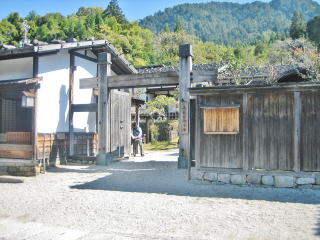◆The Shogunate-Regime and The Stage-Towns◆
The Shogunate gonernment established main Kaido-roads in order to spread their authority and influence over every province. To penetrate their power, they constructed a system of the inland traffic and communication-channels. Then the Kaido-system is the important military-political apparatus.
The authority selected the strategic key-towns and nominated them as the Stage-Towns along the roads, for utilaizing the transportation and securing the logistic safety and smoothness.

The Headquarter of Tsumago-juku : Honjin
Each Stage-Town had to manage the official house for staying and rest, getting ready for food-supply, to prepare personnels and horses for transportation. Thereby the towns supplied necessary services for travellers for the official tasks or the clan-lords travelling, who were obliged to pay the courtesy visit for Shogun in Edo, for showing their loyalty.
The lords were obliged to parade with their vassals to Edo.
The official house of the Stage-Town was called Headquarter Camp, Honjin in Japanese. The Chief of the town managed the house as family-business.
On the other hand, the persons who managed the procedures of
transportation and communication ware called Toiya (or Ton-ya) in Japanese, originally meaned the wholesaler, a kind of the commission agent nominated
by authority. The people assisting him were called Aged Persons, Toshiyori in Japanese. Under control of those perons, Temma-yaku i.e. Relayers arranged the relay of transportations.
Each Stage-Town had own chrged-territory, where the town was responsible for transporting goods. They would take over the loads from previous town and hand over to next one.
Each town had to reserve certain number of units for traffic, i.e. at least 25 walker carrying loads and 25 horses for burden. Each horse was to be taken care and controled by a proper person.
When the demand for trnasportation were too much for the personnels or the horses prepared in ordinary, the additional personnels or horses had to be raised by the managing staffs.
◆Task of Toiya-office◆
The managing staffs had to pay fee to personnels and horses
used for tranportations including the additional ones. For the paymant, they collected contributions imposed on the shops and the rich people in their town.
To cover shortage-maney for such additional payment, they might appeal the petition requiring the fiscal support to their clan-lord or the Shogunate government .
In such a case, Toiya used his money saved for the payment as charges forward for a time untill the authority compensate the expense.
Then people managing the business needed a quite some lot of property.
Therefore the most prosperous merchants or the families of the property must have been nominated as Toiya and Toshiyori. The masters of Honjin often holded the post of Toiya in addition.
◆Stage Towns and Currency-Economy◆
Preparing the official inn-house, personnels and horses and supplying services for the travellers for the official task, basically for no fee, were the tax imposed on the Stage-Towns.
However, the travellers with the official task or the clan-lords would pay some kind of tips, or the special fee for exessive services. Of course the ordinary travellers paied money for the price of staying, eating or drinking something, and purchasing goods. Those transactions gave the town quite much income.
Thus the prosperous Stage-Towns held the position controling the commercial trades and commodity-circulation in peripherial zones. For example the predominant merchants of Narai town grew the manufacturing industries of neighboring villages under their control.
The currency-economy was spreading through/along Kaido-roads and the Stage-Towns.
| previous page | next page |
